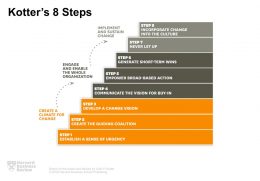 Last week, we continued our overview of ‘Kotter’s 8 Step Process for Leading Change’. As an overlay to a Strategic Planning Process, these steps can be highly effective, and can take place concurrently, depending on the nature of the programme.
Last week, we continued our overview of ‘Kotter’s 8 Step Process for Leading Change’. As an overlay to a Strategic Planning Process, these steps can be highly effective, and can take place concurrently, depending on the nature of the programme.

We are now moving onto the first step in ‘Engaging and Enabling The Whole Organisation’ which Kotter describes as:
Step 4 – ‘Communicate The Vision for Buy-In’
Irrespective of who defined the change vision the need to communicate it is a critical next step in engaging and enrolling people at all levels and in all areas across the organisation. Unfortunately, many leaders outsource communications to the ‘comms person’ or ‘comms team’ and then wonder why people ‘don’t get it’. Ownership of the communication process by the leaders is vital.
Devote sufficient time and energy to communication
A communications’ strategy and supporting communications’ plans are time and resource intensive to create and deliver well, and require a breadth of relevant expertise. Many leaders confuse their ability to communicate well in front of a compliant audience with the harsh reality of major change or transformation. When that change involves potentially significant turbulence and personal impact for many people, the once adoring ‘compliant’ audience very quickly turns into the full spectrum from strong, committed advocate to deep, disruptive and damaging cynic.
Communicating the vision for buy-in requires an understanding and expertise in effective communication strategies, combined with the ability to enrol people, rather than simply announcing it or telling them.
A communications strategy could include:
- Clearly defined outcomes and objectives
- Specifically identified and targeted audience or audiences
- Core and key messages
- What’s being communicated
- Who specifically is responsible for which communications
- When will it be done by
- How progress will be monitored
- How success will be measured
Considerations affecting Enrolment:
- Telling is not enrolment
- What you say and what people hear are often not the same thing
- If someone believes they cannot say ‘No’, they are unlikely to say ‘Yes’ in a way that is meaningful
- If you or the person you are enrolling are not authentic, true enrolment will not happen
- Commitment to do something is the outcome of effective enrolment
- Enrolment begins with you – if you’re not enrolled, you are unlikely to authentically enrol others
- You’re always leaving an impression – loose conversations & chatter kill enrolment
- We spend a lot of time enrolling people in things – being intentional, focussed and structured will help
- Showing vulnerability is not a weakness
You cannot over-communicate!
For everyone to truly embrace the vision, they need to hear it over and over – everywhere. The risk of over-communicating is unlikely to materialise! Leaders need to be relentless about ensuring that their communications and behaviours are consistent with what they’re asking people to do or to change. Nothing undermines a change or transformation more than leaders behaving inconsistently with the vision. It’s a key role of the Guiding Coalition to put the vision everywhere. It needs to be incorporated into all communications and regularly referred to — and reinforced — in meetings, conversations and wherever opportunity arises to talk about the vision.
Dissenters?
Actively seek dissenting voices; welcome them, embrace them, engage with them and, more often than not, they will become advocates and become enrolled. They will already have added value to the programme by their challenges. Weak, insecure leaders get defensive very quickly!
